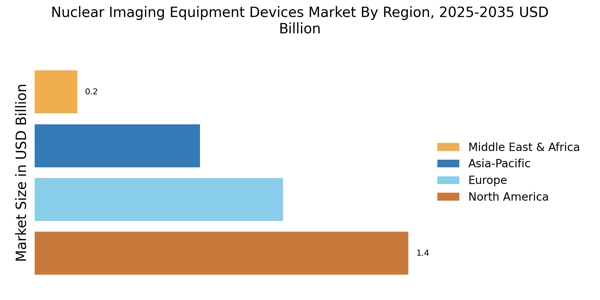Expansion of Healthcare Infrastructure
The Nuclear Imaging Equipment Devices Market is positively impacted by the expansion of healthcare infrastructure in various regions. As healthcare facilities upgrade their diagnostic capabilities, the demand for advanced nuclear imaging devices is expected to rise. Investments in hospitals and diagnostic centers are increasing, particularly in emerging markets, where access to advanced medical technologies is becoming more widespread. This expansion is likely to create new opportunities for manufacturers and suppliers of nuclear imaging equipment, contributing to market growth. The overall healthcare expenditure is projected to increase, further supporting this trend.
Growing Focus on Personalized Medicine
The Nuclear Imaging Equipment Devices Market is witnessing a shift towards personalized medicine, which emphasizes tailored treatment plans based on individual patient profiles. Nuclear imaging technologies are integral to this approach, as they provide detailed insights into the biological processes of diseases. By enabling clinicians to visualize and understand the unique characteristics of a patient's condition, these devices facilitate more effective treatment strategies. The market is likely to benefit from this trend, as healthcare providers increasingly adopt nuclear imaging to enhance patient outcomes and optimize therapeutic interventions.
Increasing Prevalence of Chronic Diseases
The Nuclear Imaging Equipment Devices Market is significantly influenced by the rising prevalence of chronic diseases such as cancer and cardiovascular disorders. As these conditions become more common, the demand for effective diagnostic tools increases. Nuclear imaging plays a crucial role in the early detection and management of these diseases, allowing for timely interventions. According to recent statistics, the incidence of cancer is expected to rise by 30% in the next decade, further propelling the need for advanced nuclear imaging devices. This trend underscores the critical role of nuclear imaging in modern healthcare.
Regulatory Support and Reimbursement Policies
The Nuclear Imaging Equipment Devices Market benefits from favorable regulatory support and reimbursement policies that encourage the adoption of advanced imaging technologies. Governments and health organizations are increasingly recognizing the value of nuclear imaging in improving patient care and outcomes. As a result, reimbursement frameworks are evolving to cover a broader range of nuclear imaging procedures, making them more accessible to patients. This regulatory environment is likely to stimulate market growth, as healthcare providers are incentivized to invest in nuclear imaging equipment to enhance their diagnostic capabilities.
Technological Advancements in Imaging Techniques
The Nuclear Imaging Equipment Devices Market is experiencing a surge in technological advancements that enhance imaging techniques. Innovations such as hybrid imaging systems, which combine modalities like PET and CT, are becoming increasingly prevalent. These advancements not only improve diagnostic accuracy but also reduce patient exposure to radiation. The integration of artificial intelligence in image analysis is also gaining traction, potentially streamlining workflows and improving diagnostic outcomes. As a result, the market is projected to grow at a compound annual growth rate of approximately 7% over the next five years, driven by these technological improvements.


















Leave a Comment